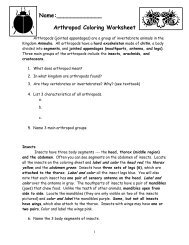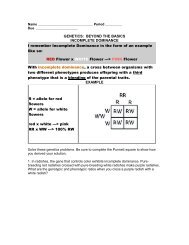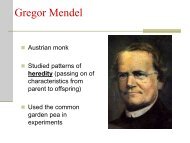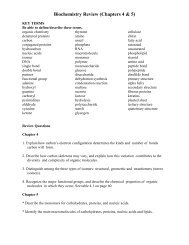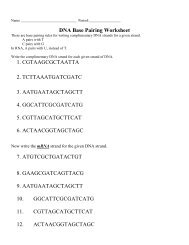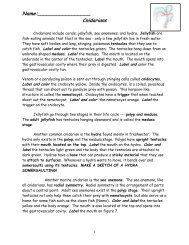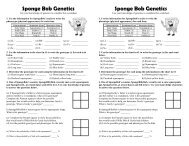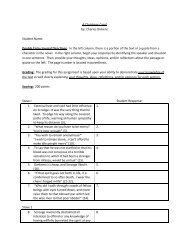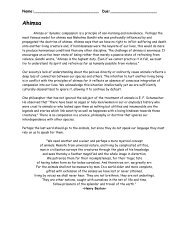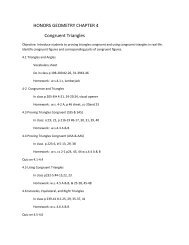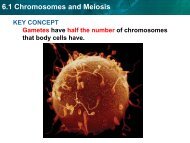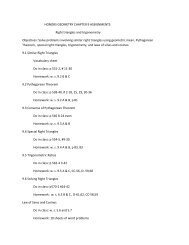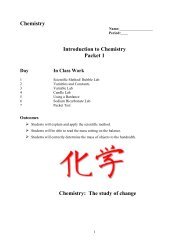Nucleic Acids WS
Nucleic Acids WS
Nucleic Acids WS
Create successful ePaper yourself
Turn your PDF publications into a flip-book with our unique Google optimized e-Paper software.
Name:______________<br />
<strong>Nucleic</strong> <strong>Acids</strong> Coloring<br />
DNA - The Double Helix<br />
Recall that the nucleus is a small spherical, dense body in a cell. It is<br />
often called the "control center" because it controls all the activities of<br />
the cell including cell reproduction, and heredity. Chromosomes are<br />
microscopic, threadlike strands composed of the chemical DNA (short for<br />
deoxyribonucleic acid). In simple terms, DNA controls the production of<br />
proteins within the cell. These proteins in turn, form the structural units<br />
of cells and control all chemical processes within the cell. Think of proteins<br />
as the building blocks for an organism, proteins make up your skin, your<br />
hair, and parts of individual cells. The proteins that are made largely<br />
determine how you look. The proteins that will be made for your body are<br />
determined by the sequence of DNA in the nucleus.<br />
Where is DNA found? _______________<br />
___________ is the instructions for making a cell's ______________.<br />
Chromosomes are composed of genes, which is a segment of DNA that<br />
codes for a particular protein, which in turn codes for a trait. Hence you<br />
hear it commonly referred to as the gene for baldness or the gene for blue<br />
eyes. Meanwhile, DNA is the chemical that genes and chromosomes are<br />
made of. DNA is called a nucleic acid because it was first found in the<br />
nucleus. We now know that DNA is also found in some organelles such as<br />
the mitochondria and chloroplasts. It is the DNA in the nucleus that<br />
actually controls the cell's workings.<br />
_______ on chromosomes code for specific ___________ in a person.<br />
DNA is also found in _____________ and ____________.<br />
In 1953, James Watson and Francis Crick established the structure<br />
of DNA. The shape of DNA is a double helix, which is like a twisted ladder.<br />
1
The sides of the ladder are made of alternating sugar and phosphate<br />
molecules. The sugar is a pentose called deoxyribose. Color all the<br />
phosphates pink (one is labeled with a "p"). Color all the deoxyribose<br />
sugars blue (one is labeled with a "D").<br />
What is meant by a double helix? ____________________________<br />
Name a pentose sugar. _________________<br />
The sides of DNA are made of _____________ and ______________.<br />
The rungs of the ladder are pairs of 4 types of nitrogen bases. The<br />
bases are known by their coded letters --- A, G, T, and C. These bases<br />
always bond in a certain way. Adenine will only bond to thymine. Guanine<br />
will only bond with cytosine. This is known as the "Base-Pair Rule." The<br />
bases can occur in any order along a strand of DNA. The order of these<br />
bases is the code that contains the instructions. For instance,<br />
ATGCACATA would code for a different gene than AATTACGGA. A<br />
strand of DNA contains millions of bases. (For simplicity, the image only<br />
contains a few.)<br />
What makes up the "rungs" of DNA? ____________________<br />
What will pair with adenine? _____________<br />
Color the thymines orange.<br />
Color the adenines green.<br />
Color the guanines purple.<br />
Color the cytosines yellow.<br />
Note that that the bases attach to the sides of the ladder at<br />
the sugars and not the phosphate.<br />
The DNA helix is actually made of repeating units called nucleotides.<br />
Each nucleotide consists of three molecules: a sugar (deoxyribose), a<br />
phosphate, which links the sugars together, and then one of the four<br />
bases. Two of the bases are purines - adenine and guanine. The<br />
pyrimidines are thymine and cytosine. Note that the pyrimidines are<br />
2
single ringed and the purines are double ringed. Color the nucleotides<br />
using the same colors as you colored them in the double helix.<br />
Nucleotides are made of a pentose ___________, a ____________, and a<br />
nitrogen-containing __________.<br />
Name 2 bases with double Carbon-Nitrogen rings.<br />
____________________<br />
The two sides of the DNA ladder are held together loosely by<br />
hydrogen bonds. The DNA can actually "unzip" when it needs to replicate -<br />
or make a copy of itself. DNA needs to copy itself when a cell divides, so<br />
that the new cells each contain a copy of the DNA. Without these<br />
instructions, the new cells wouldn't have the correct information. The<br />
hydrogen bonds are represented by small circles. Color the hydrogen<br />
bonds grey.<br />
____________ bonds between bases must be broken to copy DNA.<br />
Copying DNA to make two, identical DNA molecule is called<br />
____________.<br />
Messenger RNA<br />
So, now, we know the nucleus controls the cell's activities through<br />
the chemical DNA, but how? It is the sequence of bases that determine<br />
which protein is to be made. The sequence is like a code that we can now<br />
interpret. The sequence determines which proteins are made and the<br />
proteins determine which activities will be performed. This is how the<br />
nucleus is the control center of the cell. The only problem is that the DNA<br />
is too big to go through the nuclear pores so a chemical is used to read the<br />
DNA in the nucleus. That chemical is messenger RNA (mRNA). The<br />
messenger RNA (mRNA) is small enough to go through the nuclear pores.<br />
It takes the "message" of the DNA to the ribosomes and "tells them" what<br />
proteins are to be made. Recall that proteins are the body's building<br />
blocks. Imagine that the code taken to the ribosomes is telling the<br />
ribosome what is needed - like a recipe.<br />
3
Messenger RNA is similar to DNA, except that it is a single strand,<br />
and it has NO thymine. Instead of thymine, mRNA contains the base<br />
Uracil. In addition to that difference, mRNA has the sugar ribose instead<br />
of deoxyribose. RNA stands for Ribonucleic Acid. Color the mRNA as you<br />
did the DNA, except Color the ribose a DARKER BLUE, and the uracil<br />
brown.<br />
mRNA has a ____________ strand of nucleotides.<br />
__________ replaces __________ on RNA.<br />
_________ is the pentose sugar on RNA.<br />
__________, not DNA can leave the nucleus through ________ in the<br />
nuclear envelope.<br />
The Blueprint of Life<br />
Every cell in your body has the same "blueprint" or the same DNA.<br />
Like the blueprints of a house tell the builders how to construct a house,<br />
the cellular DNA "blueprint" tells the cell how to build the organism. Yet,<br />
how can a heart be so different from a brain if all the cells contain the<br />
same instructions? Although much work remains in genetics, it has become<br />
apparent that a cell has the ability to turn off most genes and only work<br />
with the genes necessary to do a job. We also know that a lot of DNA<br />
apparently is nonsense and codes for nothing. These regions of DNA that<br />
do not code for proteins are called "introns," or sometimes "junk DNA.”<br />
The sections of DNA that do actually code for proteins are called<br />
"exons."<br />
__________ are non-coding segments of DNA.<br />
Questions:<br />
1. Write out the full name for DNA.<br />
2. What is a gene?<br />
3. Where in the cell are chromosomes located<br />
4
4. DNA can be found in what organelles in the cell?<br />
5. What two scientists established the structure of DNA?<br />
6. What is the shape of DNA?<br />
7. The sides of the DNA ladder are composed of what?<br />
8. The "rungs" of the DNA ladder are made of what?<br />
9. What sugar is found in DNA? In RNA?<br />
10. How do the bases bond together?<br />
A bonds with _____ G bonds with _______<br />
11. The two purines in DNA are_____________ and ___________.<br />
12. DNA is made of repeating units called _______________.<br />
13. Why is RNA necessary to act as a messenger? Why can't the code be taken<br />
directly from the DNA?<br />
14. Why is the DNA molecule referred to as the "blueprint of life"?<br />
5
DNA Molecule<br />
6



